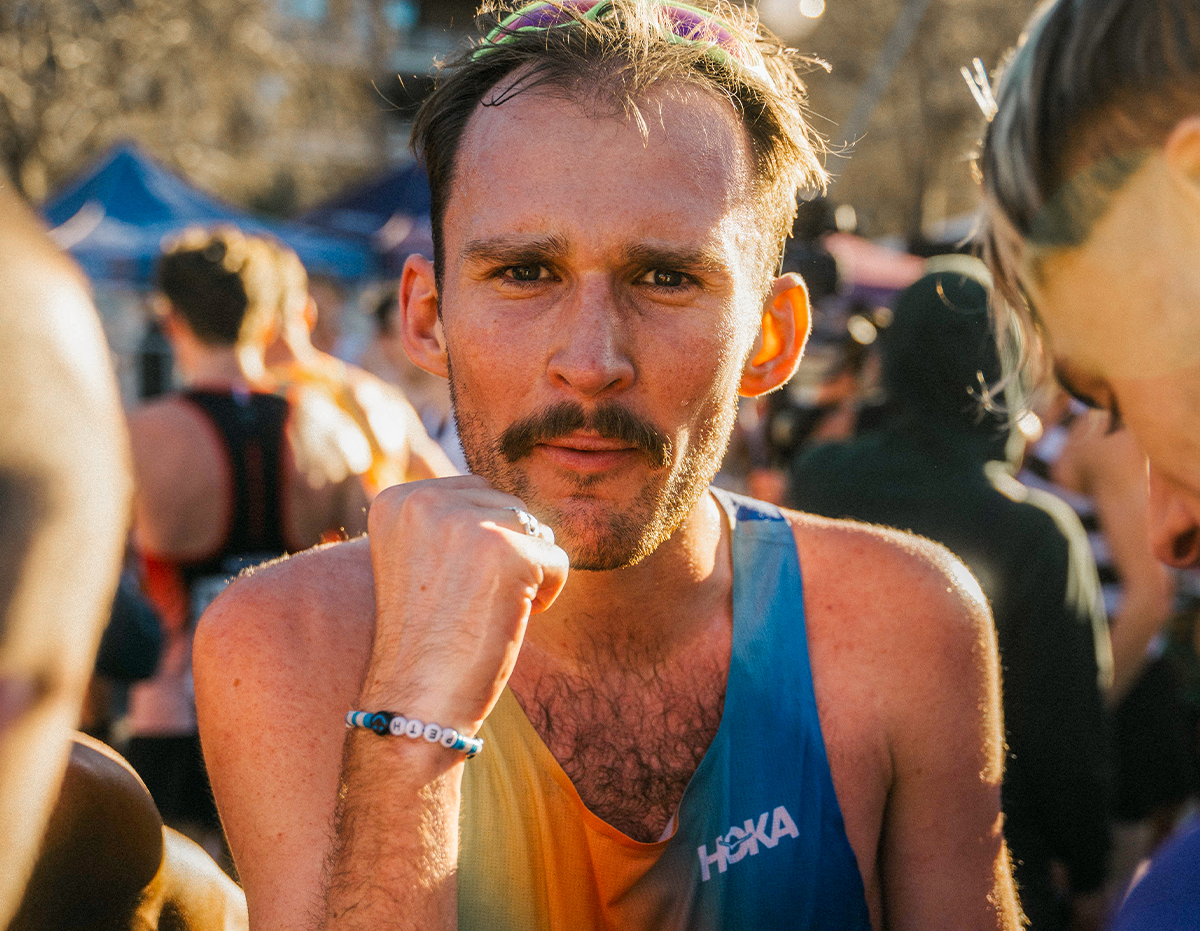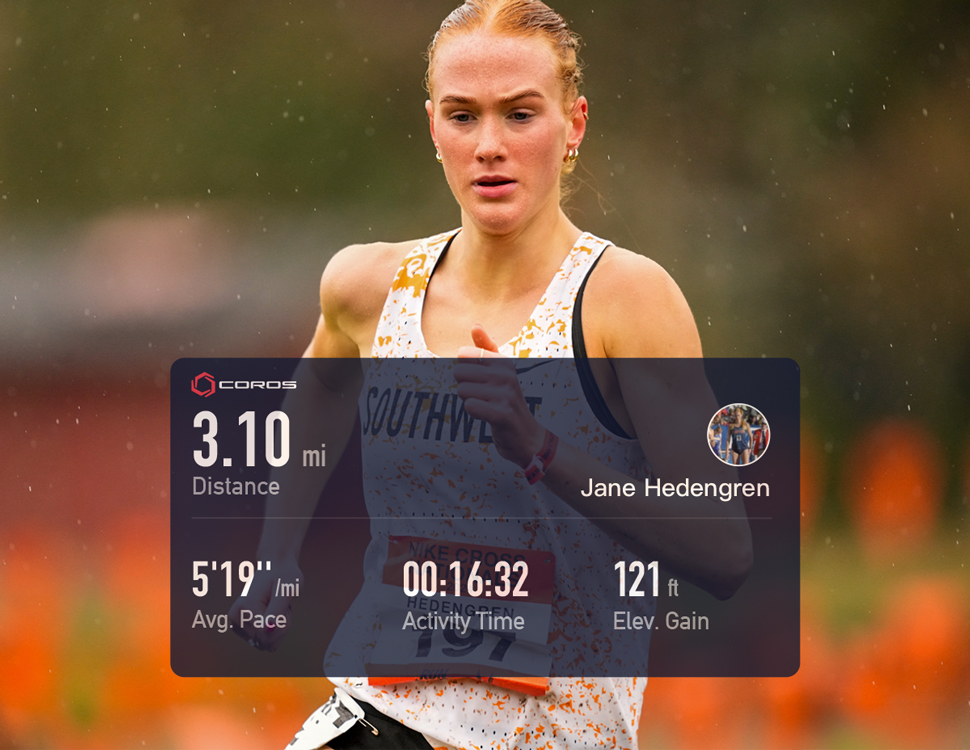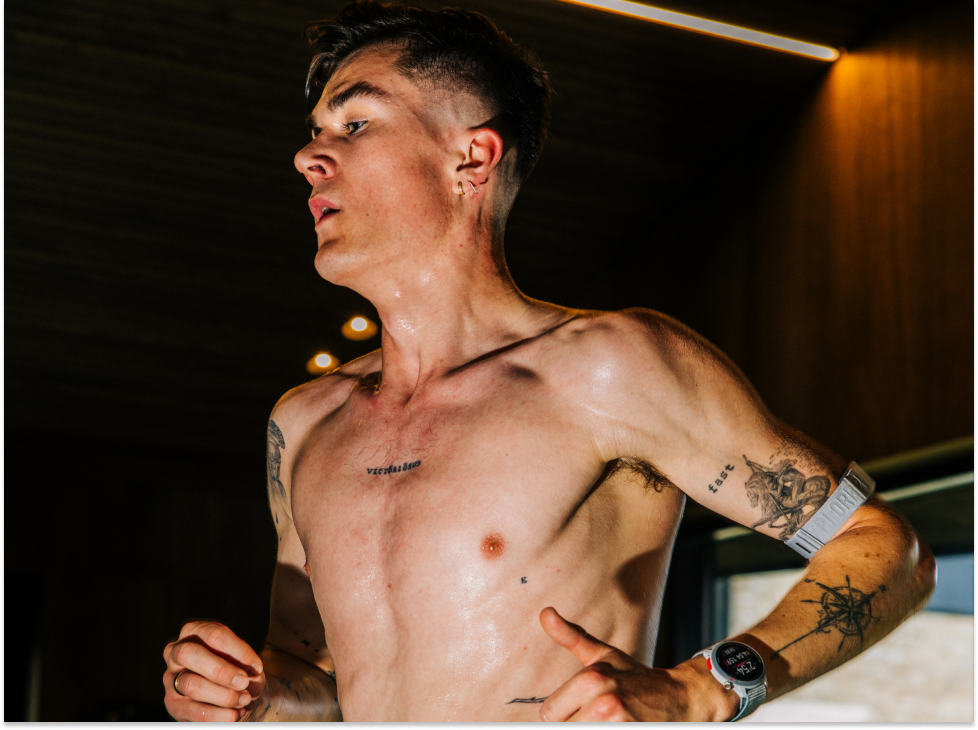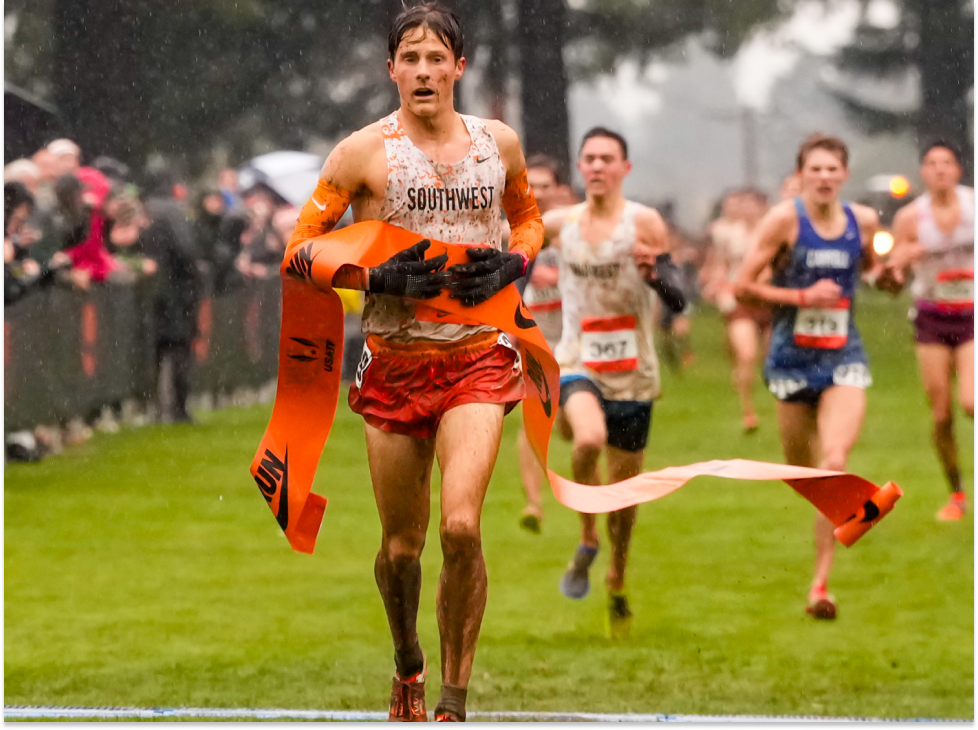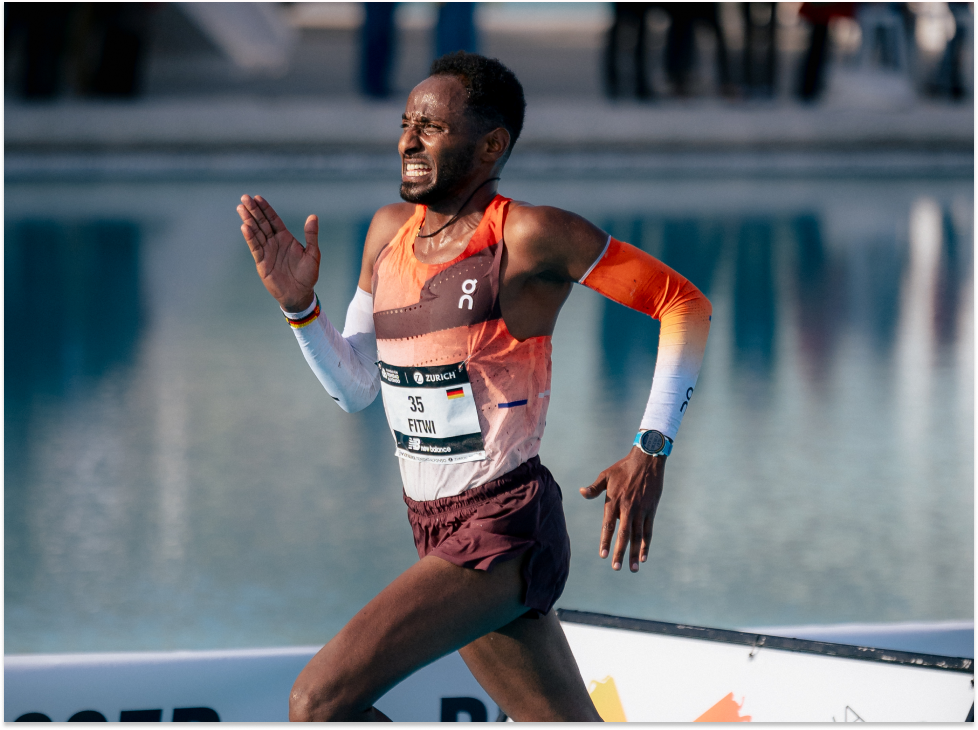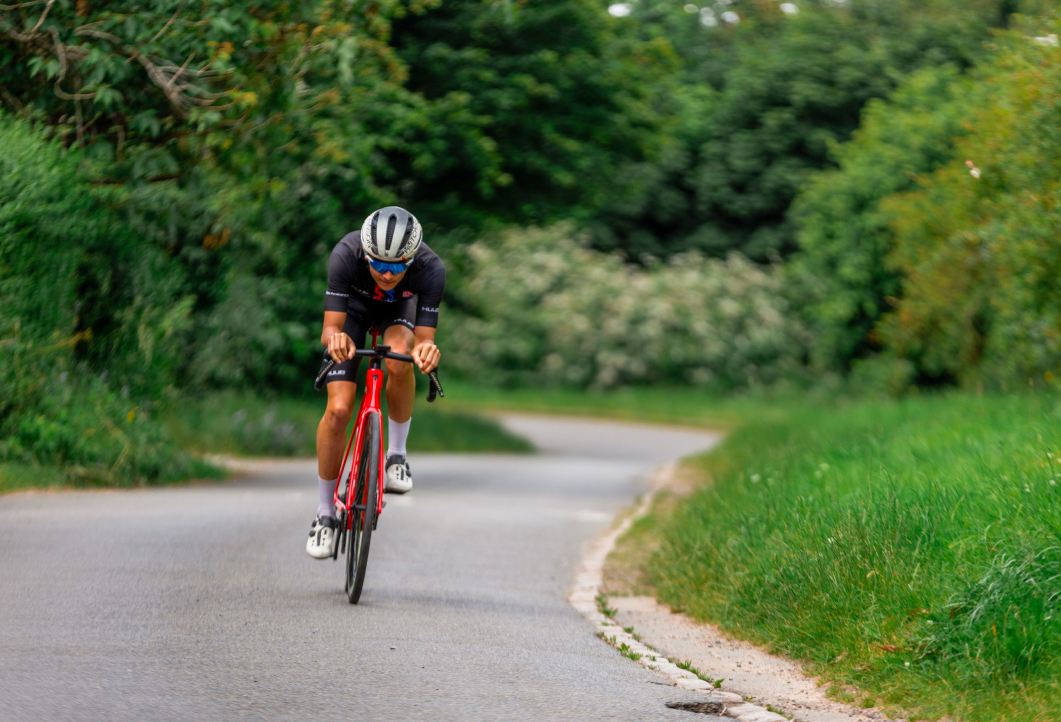Reese Vannerson is currently the No. 1 ranked Junior Triathlete in the world. His path toward achieving this may be different than what you expect. While many youth athletes have trended toward specialization in a sport, Reese found joy in changing his focus with each season. As Reese eyes his final race as a junior, The World Triathlon Junior Championships on Oct 18th, he reflects back on his journey and shares insights into his training approach in the hope it helps other young athletes moving forward.
Editor's Note: I have been fortunate to work with Reese as his data performance coach from the age of 10-18. Over these 8 years, we developed key principles to set Reese up for long-term success. While Reese will share his thoughts for youth looking to improve in the sport, I will also add coaching insights and why certain steps were taken along the way.
Building an Athletic Foundation While Having Fun
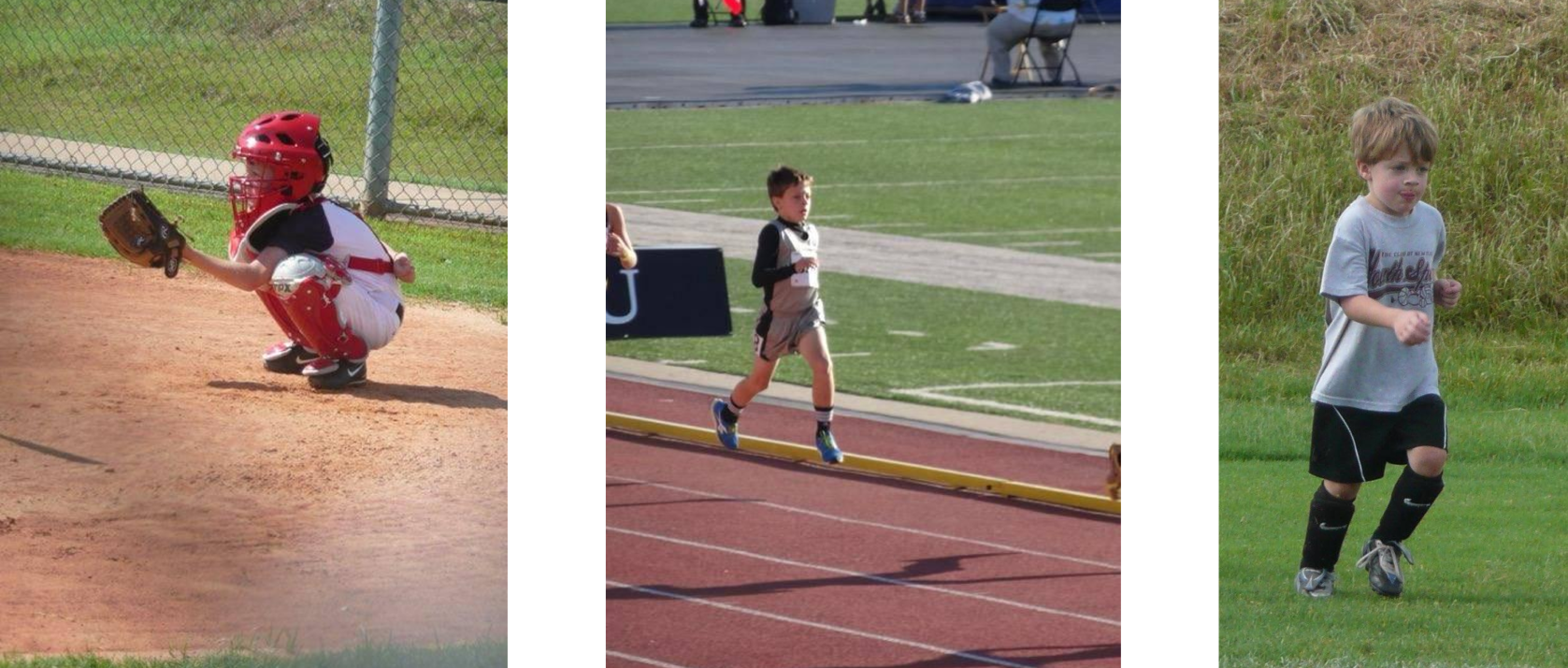
Reese competing in youth baseball, track & field, and soccer
Reese has always been a kid that likes to move. Like many youth around the world, Reese enjoyed being outside, and having fun. Supported by his parents Rodney and Lisa Vannerson, they prioritized giving Reese an opportunity to find what made him happy.
At the age of 3, Reese started with the sports of Soccer and Gymnastics. As he turned 5, Reese tried baseball and ultimately remained within this sport until the age of 12. During this same time, Reese also joined football, basketball, and swim teams (ages 7-11) along with an AAU Track and Field program (ages 8-15). Starting around age 8, Reese tried a few triathlons per year to spend more time with his closest firends. He basically played anything and everything, all in the name of fun.
Throughout his younger years, he learned about the power of community within sports, building relationships with his teammates (which he continues to this day), and the camaraderie of achieving a goal as a team.
"I played these sports to be outside and have fun. I had a lot of energy and I enjoyed the competition. I've always wanted to do well, but that wasn't really my focus until I turned 12. I remember having to choose between a baseball tournament or AAU event and ultimately chose track. I fell in love with the sport and this is when I really started to focus on performance and actively trying to become better."
Coaching Insight: There is no research showing specialization at a young age aids in the long-term development of a junior athlete. In fact, it's actually the opposite. Through playing multiple sports, it allows the athlete to develop skills such as agility, strength, and speed, while at the same time learning life skills such as teamwork, decision making, and recovery.
Middle School Training: Ages 12-14
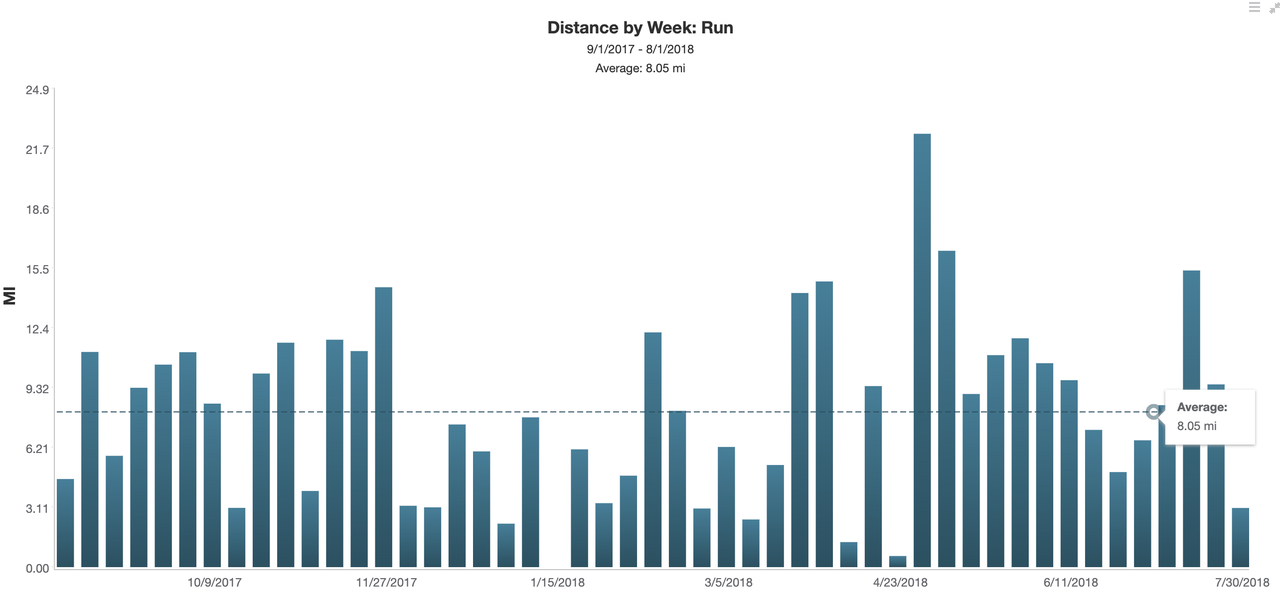
Reese Saw a Peak Weekly Volume of 22.5 miles while averaging only 8.5 miles/week from 2017-2018
As Reese began to focus more on his love of running, he took a different approach than that of his peers. While most of the high performing youth athletes across the nation were running upward of 30 miles per week, Reese averaged between 8-10. His running was almost exclusively structured interval training on a track. This lasted the entire 3-year span of middle-school. While this approach ultimately led Reese to where he is today in terms of ability, it wasn't always the easy choice.
"I didn't like that it took me longer to develop vs the kids I was racing. Higher mileage tends to get people fit faster and I knew they were running more than me. Once I bought into the method, I really applied myself. It didn’t happen as quickly as it did for the others, but I started to see the benefits and I wasn’t suffering from any of the injuries the other kids were going through. By the time I was entering high-school, I was reaching heights that others hadn't. I had to learn to be patient and now I can reflect on this and realize it isn't about being the best at 12 years old, but instead setting yourself up for long-term improvement. There are a lot of kids I raced against that have been unable to maintain their performance over time. I still feel like I have a long way to go before I hit my peak in the years to come."
Coaching Insight: “Quality over Quantity” is the concept of doing less volume with more intensity. Interval training can be the baseline for running development, so long as recovery is always part of the equation. This allows for a larger focus on form and fundamentals, without putting unneccesary stress on the body. It's important to remember children this age need to be trained by age appropriate methods to avoid over training injuries. Shorter practice sessions also keep it fun. Once training becomes work, children lose interest and long-term development becomes exponentially harder. To ensure we always knew what was going on, Reese began tracking all workouts through his GPS watch.
Typical Training Session: Middle School
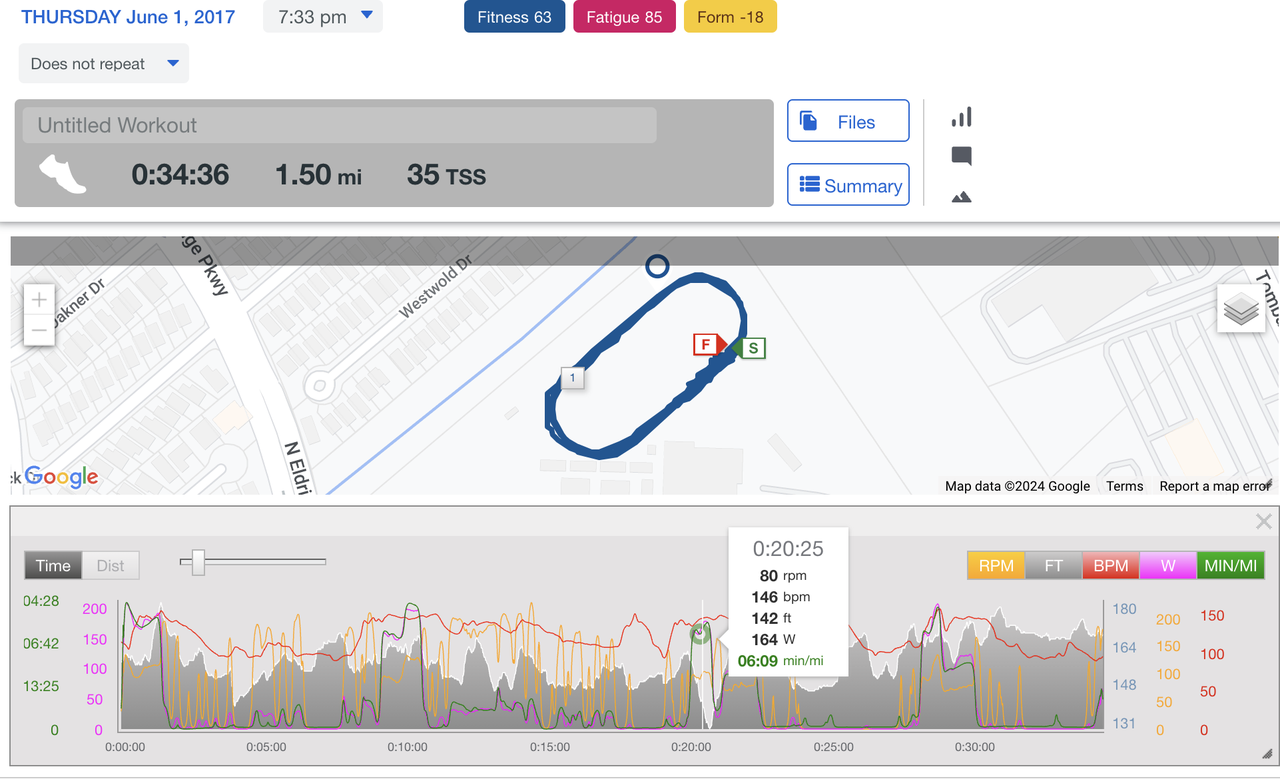
Reese's Quality Sessions Had Multiple Focus Points With Plenty of Recovery
From 12-14 Years old, this was a typical workout for Reese:
4x400 meters with 200 meters surging and 200 meters steady. Roughly 6 minutes recovery between efforts.
At only 1.5 miles total, this allowed Reese to get quality speed development (turnover), limit the exposure to any unnecessary stress (limited duration), and also taught him the importance of pacing (steady pace after a surge), which is a learned skill.
"I give a lot of credit to Coach Andy Stewart for helping me through this portion of my career. He was very good at working with younger athletes and teaching us the importance of pacing and getting the most out of our own ability. As I focused more on track during this time, I ultimately learned how to run an entire race at a high effort, but within my own ability. He taught me each new PB was a win, even if I didn’t win the race. I still use that mindset a lot."
Cross-Training
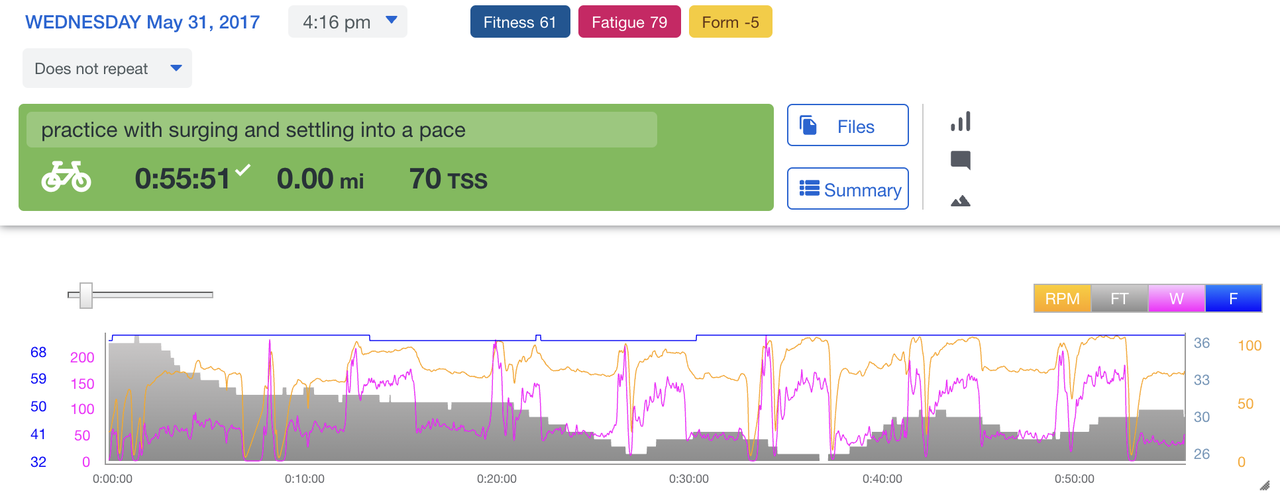
Reese performed many sessions on the bike during his youth development
Cross-training is the recipe behind injury free development. It’s growing in its use, but still underutilized for today’s youth athletes, specifically runners. From the age of 12, Reese off-set his lack of running volume through cross-training.
It’s a given that endurance athletes need to add volume as they advance in their sport. At younger ages, those increases are often too stressful for such a young frame. That’s where injury generally sets in. We found off-setting running loads through cycling and swimming was beneficial in developing Reese’s fitness, while at the same time, it avoided growth plate issues, stress fractures and other common youth related running injuries. The impact that running causes on his legs and joints was greatly reduced and he was able to continue his development without interruption.
"My biggest takeaway from adding cycling to my training is that it kept me healthy. I rarely ever had a running injury growing up. I found cycling to be very easy on my body, but also found it to be a lot of fun. Coach Derek (Dalzell) and I would ride on ZWIFT and focus on things like visualizing a running race, or associate efforts I was feeling on the bike with similar feelings I would experience on the track. This type of training helped me become a better runner off the bike as I transitioned into triathlon as my main sport. It allowed me to build fitness, develop mental skills, and enjoy my training while not pushing myself too hard on the run. I never felt burnout. If I got tired of one way of training, I could always switch to another."
Reese won multiple AAU Junior Olympic Championships in the 800m/1500m/3000m distances during this period. The focus of his training was to keep things fun, not overstress his body, but allow for yearly improvments. He was training at a higher intensity level than he did as a grade-school athlete, but we always found some kind of a game to play to keep it light hearted.
Early Triathlon Years
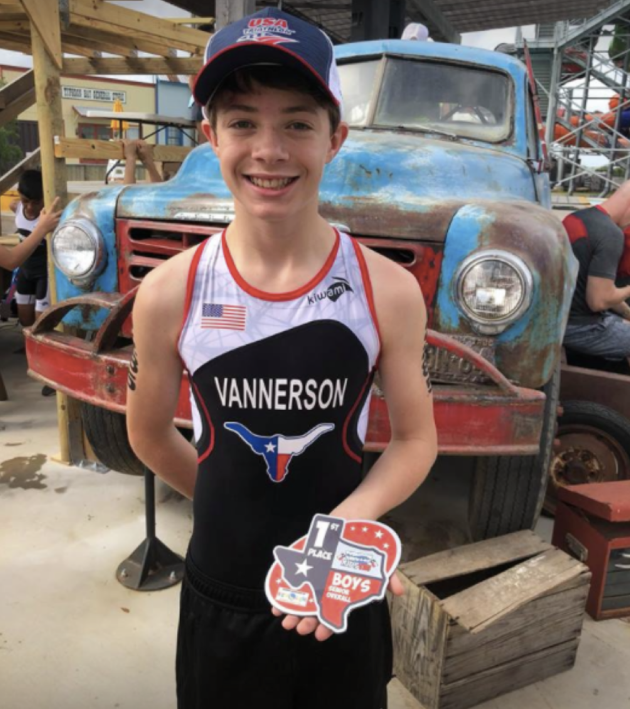
Reese During His Youth Triathlon Days
Reese raced his first triathlon at the age of 8 years old. It was the Houston Kid’s Triathlon in Houston, Texas. He finished 3rd in his division and couldn’t wait to do his next one.
"Some of my friends were racing and it was a way for me to compete with them. I liked the sport from the start. I thought it was cool.”
From the ages of 8-15, Reese found success with his running ability, but didn't really take the sport seriously until the age of 15. Due to scheduling conflicts between AAU Junior Olympics and USAT Triathlon Nationals, Reese had to choose which National Championship he wanted to compete in. USAT Youth Elite Nationals were on the same day as his last AAU race. He could only compete in one of them. He ultimately chose to run AAU, and settled for age group nationals in triathlon. It was the only way for him to compete in both.
Throughout this 7-year span, Reese was without a doubt a runner first and foremost, but was developing as a triathlete due to his cross training. At the age of 15, Reese joined his first triathlon team, Alpha MultiSport, where he was under the guidance of Coach Sara Dasso. This is where his interest in triathlon really began to grow.
"Coach Dasso helped me understand that the process is more important than the result. She helped me stay level-headed and look forward vs getting stuck on a result. Our conversations were always about process goals, not outcomes."
Later that year, the scheduling between the two National Championships finally allowed Reese to race a USAT Youth Elite National Championship. He won, making it his first triathlon national title. Given his cross-training focus from a young age, Reese was able to maintain contact with the lead swimmers and cyclists during the early parts of the race, but the run is where he shined. The win gave him the positive reinforcement that his training was working. He maintained his multi-sport approach to training throughout his high school career.
"During the school year, I would focus on track. In the summer when I didn't have school priorities, I would switch to being a triathlete. It didn't bother me that others were better than me when I moved to the Junior ranks because I saw myself as a track athlete. I never had the year-round focus on the sport like some kids, but I was okay with that. Following the summer, I would go into my school’s cross-country season where intensity was a bit lower. This allowed me to recover and work on my base for the following season."
High School Years
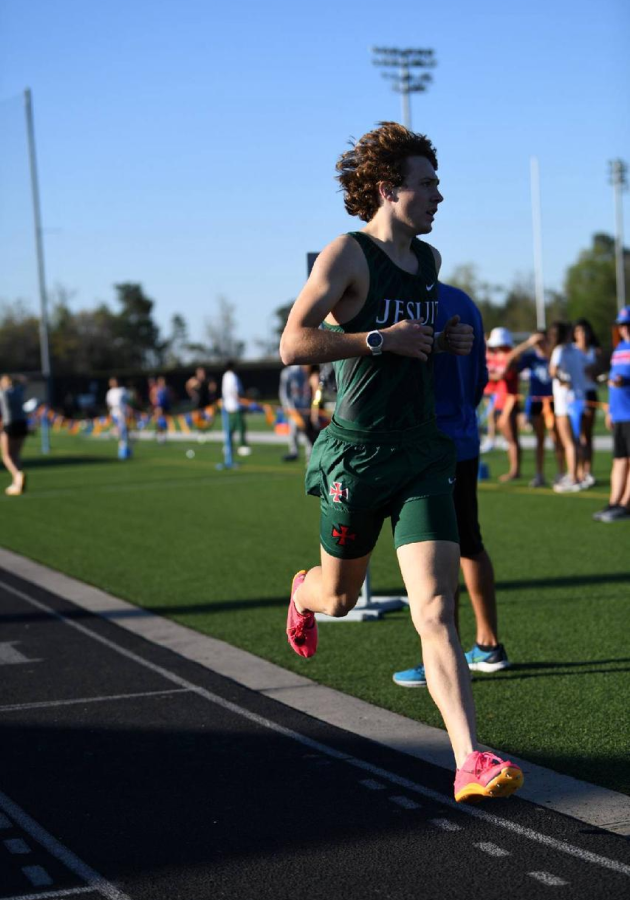
Reese During His Strake Jesuit Days
Building on his success from his youth years, Reese ultimately went on to winning the Texas 6A state championship in the boys 1600m (4:08.08) and 3200m (8:49.10) his senior year. Throughout the 4 years, Reese learned life lessons, experienced defeat, but stuck to his approach that had made him successful up until this point.
"There is nothing like the feeling you get from being a part of a team. I was able to find camaraderie in many of my sports growing up, but high school was on a different level. It's far more competitive. Coach Kerley was great at getting our team to understand our roles and buy into them. He taught me about leadership and what it meant to earn as many points as I could for our team. He taught me how to race to my strengths, as well as knowing how to switch gears and improve my kick. He's the one that taught me to have a winning mindset."
Training Approach
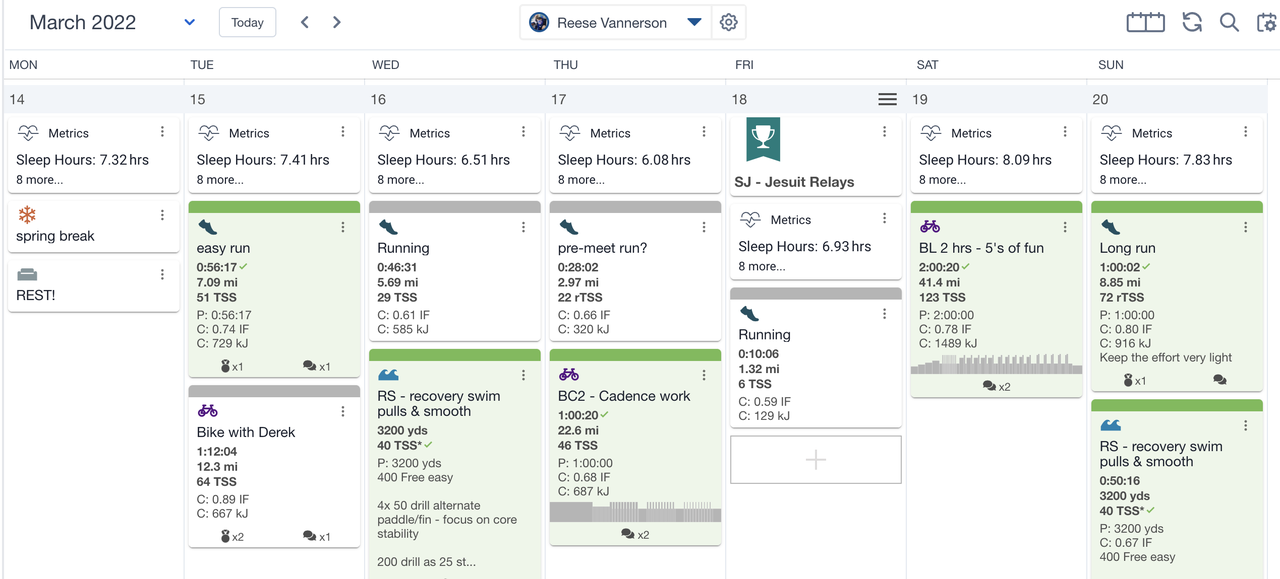
Typical Training Week During Reese's High School Career
During high-school, Reese saw his volume increase, but those increases were always below the range of most high-schoolers competing at his level. To offset the lack of endurance, Reese maintained his cross-training approach. We embraced the structure and benefits provided by the US high-school athletic system, and built his cross-training around it. After Coach Michael Kerley would establish his run training calendar, we would schedule his rides and swims around it. Reese was riding anywhere from 1-3 sessions per week along with a few swim sessions. With running being the clear focus and champion of his training schedule during the season, the other training was to supplement his volume and develop more fitness. Cross-training allowed Reese to excel in the development, but kept things fun, reduced the risk of injury, and ultimately helped him toward his endurance goals.
Freshman Year
Coming in as a Freshman, Reese averaged 16.5 miles of running per week over his first year. Peaking at 35 miles during cross country season, Reese followed a periodized approach throughout his four years. XC season was always for base building on the run (lower intensity in cross-training), followed by higher quality sessions on track along with off-setting cross-training for both performance and recovery.
Sophomore Year
Year two of high school saw a steady increase in volume which resulted in 25.2 miles per week on average. To off-set this, Reese focused more on active recovery within cycling and swimming to ensure his body could handle the new demand.

Junior Year
Year three saw another jump from 25.6 to 30.1 miles per week. The major difference this year was a steady approach to mileage throughout the year without the large fall off during track season. Reese was already competitive in the 1600m, but building form in the 3200m and 5000m events.
Senior Year
Reese's Senior year maintained nearly the same level, going from 30.1 to 29.6 miles per week. With a nearly identical build in place, Reese found more training volume in cycling and swimming as he began gearing up for larger triathlon events along with his State Championship ambitions.

Difficult Decisions During his High School Career
Like many high-school athletes, there is more to life than just sport. This is a formidable time for developing social skills, learning who you are, learning what you like, along with juggling many other challenges that arise each day. Balancing everything that goes into a day of a high school student-athlete often involves not being able to do things you want to.
"I sometimes would have to miss things because of my training schedule, but I don’t think of this as missing out. Sure, I wouldn’t be able to stay out really late with my friends if I had a big session the following morning, but I knew what I wanted to accomplish and I knew what was best for me to accomplish those goals. I enjoyed training more than I did staying out late. I never really feel like I sacrificed anything. I just made choices based on what I wanted to achieve."
Beyond the decision of high-school social interactions, there were many difficult choices to be made as major triathlon events popped up during his school year that were in conflict with his high-school competitions. For example, USA Triathlon Junior World Team Qualifiers would often be scheduled the same week as postseason track events. He was the reigning National Triathlon Champion, but had to depend on discretionary selection the first two years he qualified for the World Team. He chose to compete with his high-school track team at Regional Qualifiers, and hoped it worked out with triathlon. Given the success that Reese was now finding in both sports, he was often being pulled in multiple directions. His allegiance was always with his high-school team first.
"I would end up missing a lot of the bigger races for triathlon when it came to cross-country season and postseason track. I always put the team first. It was definitely hard as you want to do everything you can, and you feel like you’re missing out. But at the same time, I realized there would be more of these races to come. I knew I only had a limited amount of time with my team, hanging out with them, going to hotels, and doing road trips. I didn’t want to miss out on that. I never told my team about the conflicts. It wasn’t necessary. I ultimately chose the team, and have no regrets."
First Year of College
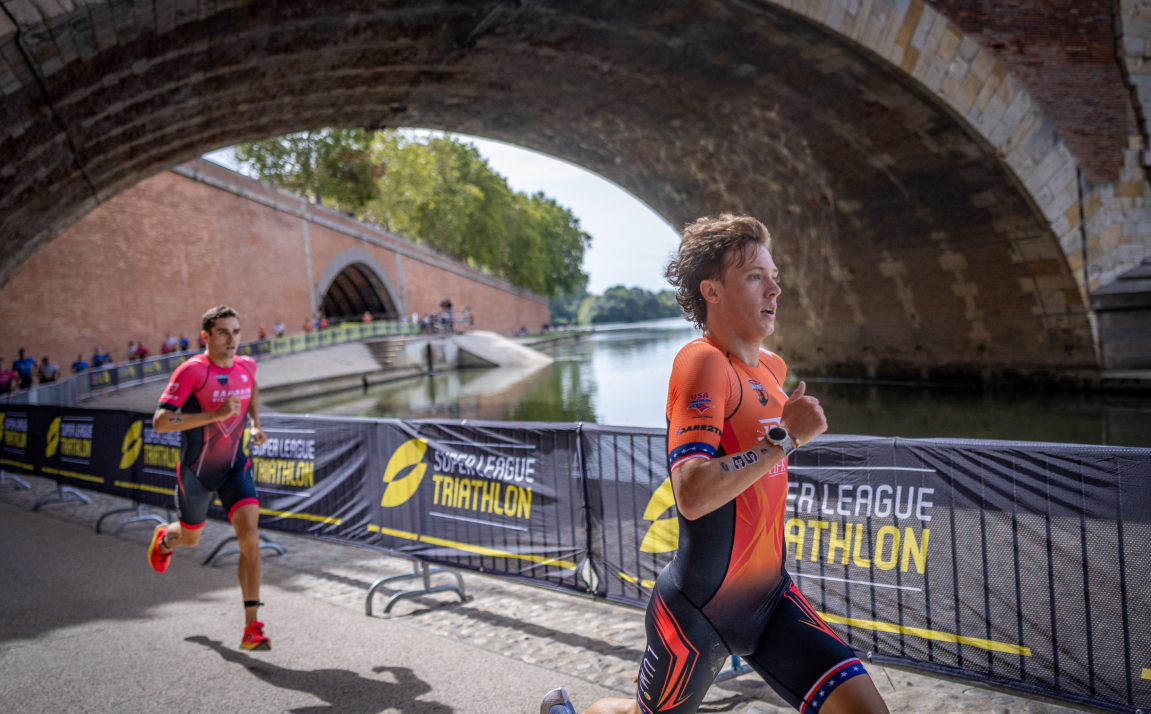
Leaving high school, Reese had a major decision to make. Would he accept an NCAA Division 1 Track offer, or pursue a career in Triathlon?
"When I was 17, I went to the USAT European Camp. It ended at the World Championships in Montreal. When I got back home, I told my parents I wanted to pursue triathlon instead of traditional NCAA track. After traveling and racing at the Continental Cup level, my path forward was clear."
This was the first time Reese made the choice to specialize in a dedicated sport. Having built a strong relationship with Parker Spencer, Head Coach of USAT Project Podium, Reese decided to focus on triathlon.
"Up to this point, I had many coaches help me along the way. They all played a role in my development. Working with so many different personalities gave me the chance to figure out who I am as an athlete, and what type of coach works best for my goals. Heading into Project Podium I knew of Parker’s coaching style, and I felt it was the best fit for my long term development."
As Reese went to his Freshman year of college, there was a major shift in his training approach.
"For the first time in my career, I wasn't a young kid who didn't train volume. Based on my development, I was in a position to build each week, but this was a big adjustment. I wasn't used to the time required. Quality sessions remained the same, but the longer weeks have shown me I have a far higher ceiling than I ever realized."
Reese's first year at college had many highlights. He was put into a position to race Continental Cup races, Super League Triathlon, and earned his selection to the World Championships for a second time.
"Super League last year was a super cool experience. I was surrounded by the top people in the sport for an extended period of time. I realized I was 18, I’m new to the professional side of the sport, and I’m not going to be able to compete with them over the full distance. I knew I could have an impact on our team points by using my strength and getting the team as many points as possible. I leaned into my experience from high-school and accepted the role I was given. I thought of myself as the 5th guy on a cross country team. I may not win, but I can get points. It was a new role for me, and I loved it."
Parker Spencer's Thought on Reese's Youth Approach
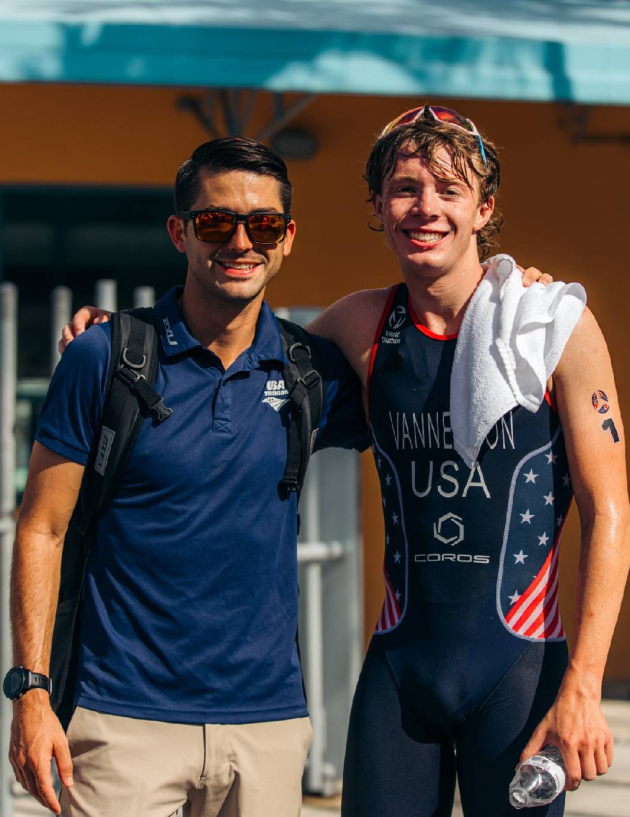
Coach Parker Spencer and Reese
When discussing Reese's youth approach with Parker Spencer, his current coach, he was hopeful more athletes would follow a similar path going forward.
"Reese's lack of volume from an early age is what got me interested initially. He was already performing exceptionally well, but without all of the volume that you may typically see in an athlete at his level. From an elite coaching perspective, this is the diamond in the rough you are looking for. It's easy to be the best junior in the U.S. if you're training with the same volume as professionals, but for me, when I'm looking for recruits coming in, if they have a lot of volume under their belt, it's a warning sign they are over developed and there isn't much I can help them with."
Going further, Parker notes how metabolic testing has only solidified his belief in Reese's approach.
"All of Reese's coaches did a fantastic job of keeping his training age appropriate. They made my job far easier. When we do VO2 testing, or analyze his entire metabolic profile, it shows that we can maintain his quality, but strategically build his volume in a safe and strategic way. He already has the foundation in place, so now he is primed to excel. We only just started working on this and we have really taken our time to allow Reese to adapt to this new method. We add a few miles per week as we target an overall training load for peak season."
Parker's notes to other youth athletes is to focus on the fundamentals first, as it will provide higher upside later on in your career.
"If you can handle higher volumes early on, sure you will get faster sooner, but that comes with a price. You risk you won't be able to develop at the rate you need to hit your overall peak as an athlete. Reese was trained at an age appropriate rate while he was growing up, and now we are starting to see what volumes he can handle for his career performance overall."
Year-to-Year Progression
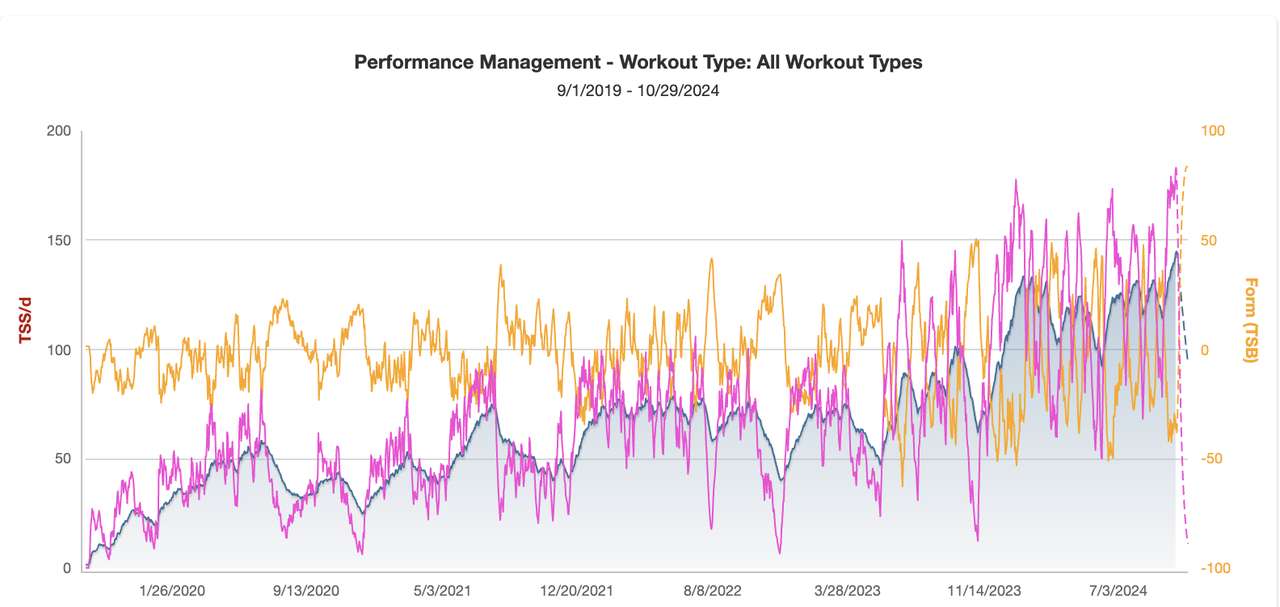
Year-to-Year progression followed by recovery during the off-seasons.
Throughout Reese's youth development, each year was viewed as a building block that laid the foundation for future years. While there was a focus on performance each year, the overall thought was to put a limit on his peak to ensure a safe and strategic approach for long term development.
One concept Reese’s parents bought into was ensuring he had the products necessary to track everything. Whether it was data from a training session, stress/fatigue from a workout, sleep, sickness, recovery, or other key figures, Reese was collecting insights into every aspect of his training process. Not only did this make it easier for tracking year-over-year progress, but it allowed Reese to learn about these concepts from a young age and incorporate them into his normal routine. This made him a smarter athlete overall and created a holistic approach to his training.
Coaching Insight: Reese has used wearable devices throughout his career. By tracking his output, we were able to fine-tune his approach and training load year-over-year. Reese made the switch to COROS in 2021 as he looked to maximize his approach.
Watch: COROS PACE 3
Heart Rate Monitor: COROS Heart Rate Monitor
Bike Computer: COROS DURA
Junior Years Farwell From Reese
Over the last 10 years, Reese has seen his friends, teammates, competitors, and rivals trajectories play out. During this time, Reese has had plenty of time to reflect, and wanted to leave his final remarks to those looking to build on their own youth performance going forward.
"In youth sports, you see athletes who excel for 1-2 years, and then come back to the field as others develop. You also hear about how much someone is running, or training, and I would wonder if what I was doing was enough. Looking back on this now, I can see it all worked out. What I would tell the youth today is to work with your parents to have a plan, listen to your coaches, learn as much as you can along the way, and be patient. The goal for youth athletes should be to improve each year, based on their individual ability, and not sacrifice long term results for short term gains."
Finally, it takes a village. Reese was in the fortunate position of having the support needed from his parents, and guidance from coaches along the way. While the performance is easy to see based on a results sheet, the lessons learned will stick with Reese for life.
"As I leave the Junior ranks, I have an immense amount of gratitude and thankfulness for sport. I have been given some of my greatest relationships and life lessons through athletics. I have found out who I am by experiencing both the good and bad that comes with it. From my younger days at AAU with High Velocity racing my teammates, to now as a member of Project Podium racing the top athletes in the world, I wouldn’t change a thing. Everything in between is what made me the athlete I am today.
I want to thank my parents for the countless amount of sacrifices they have made to get me where I needed to be, and for always being there for me win or lose.
I want to thank Coach Jerrome (Forest) and Patrick (Benson) from my AAU days who were the first to teach me about work ethic. They told me this sport was hard, but they also taught me how giving effort will build enjoyment through the process.
Coach Andy (Stewart) who taught me about patience through the art of pacing, and how this concept carries over into many aspects of life.
Coach Derek (Dalzell) who helped me with goal setting and visualization prior to races. Being able to know what we were working for, and visualizing the result helped me prepare for both training and races. He’s the first coach that I could talk to about things outside of sport. He’s there with me through every big result I’ve ever had.
Coach Sara (Dasso) who shared with me how to move on from difficult results and stay level-headed throughout the process. She taught me to embrace the sport that is ongoing and helped me figure out the path I wanted to take post high-school.
A special thanks to my high school coach, Coach (Michael) Kerley who helped me understand leadership and being part of a team. He taught me how to win, be a man for others, and learn that everyone on a team has a role.
And finally, to Coach Parker (Spencer) for showing me how to be efficient, both in training and racing. He continues to teach me how to grow from a teenager to handling the professional triathlete lifestyle moving forward.
I have one more race as a junior athlete and this race is dedicated to these individuals. I can’t thank each of them enough.”
Conclusion
On Friday October 18th, Reese Vannerson will line up with the #1 on his bib for the World Triathlon Junior Championships. Following this race, he will enter events only as a professional. What Reese accomplished is not by coincidence, but rather by following a detailed plan and tracking progress along the way. Insights from training data, along with mentorship from his coaches allowed Reese to develop to a high standard without the need for specialization.
As Reese sets his eyes on his ultimate goal of representing Team USA at the highest level, he takes with him the lessons he learned, and the blueprint of success that was built along the way. COROS looks forward to continuing our journey with Reese as he elevates into the professional ranks, and continues with his progress year-by-year.
For more information on COROS and how you can start tracking your progress, visit www.coros.com
/fit-in/0x18/coros-v2/images/common/logo_black.png)
